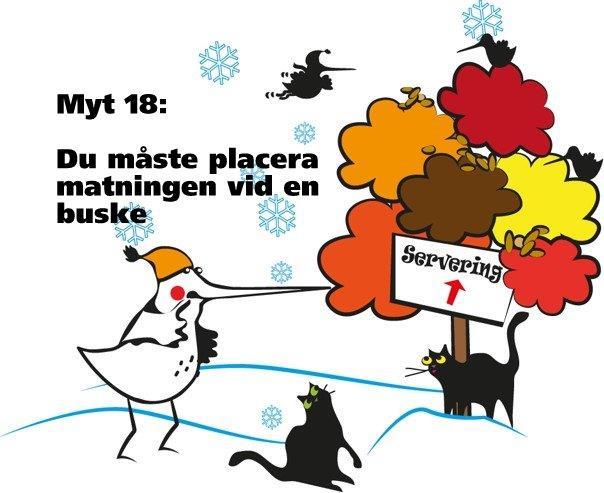There are many myths surrounding bird feeding. We’ve gotten to the bottom of 24 of them!

You must place the feeder near a bush!
The need for protection for small birds is exaggerated - some birds actually prefer to forage in a more open area. They feel secure in the openness and can be safe from ambushes. From a cat, for example.
The idea behind this myth is that feeding stations should preferably be placed inside a dense bush to protect the birds from hawk attacks. However, on the other hand, this often invites cats to lurk. It also becomes more challenging to move the feeding station for hygiene reasons (read more in myth 6) and in some cases to see the birds. Additionally, birds do not discover the feeding station as easily if it is hidden in a bush.
 Who would you prefer to invite for a small bird lunch? Photo by Thomas Hildh (Sparrowhawk).
Who would you prefer to invite for a small bird lunch? Photo by Thomas Hildh (Sparrowhawk).
In England, they say the opposite!
The funny thing about this myth is that in England, they think completely the opposite. There they say: "Place the bird feeding station as openly as possible to not give cats a chance to ambush." 2-0 England-Sweden. Cats are not a part of our natural ecosystem and are a big problem for wild birds and small rodents (which are the food base for many other birds and animals). It's better to lose a bird to a bird of prey than to a cat! Our wild birds of prey are just as valuable as the small birds. That they come and take birds at a feeding site is entirely natural. Read more about cats and bird feeding in myth no. 15
Birds have different behaviors.
Open bird feeders are more suitable in agricultural areas as they attract more open-field birds such as the yellowhammer, tree sparrow, house sparrow, jackdaw, crow, and redpoll. These birds prefer feeding on the ground with an unobstructed view. There are a few very rare species, like the twite, horned lark, skylark, lapland bunting, and snow bunting, which require a significantly open area around the feeder. On the other hand, many species prefer proximity to bushes, such as thrushes, dunnocks, blackcaps, robins, and long-tailed tits. However, all these species will come to the feeder if it's situated openly enough, just a bit further than a cat's leap from a bush or hedge. Most species are not particularly concerned – what's important is that they find food.
 The robin is one of those that feels safe under bushes. Photo by Barbro Nelly.
The robin is one of those that feels safe under bushes. Photo by Barbro Nelly.
So how should we place our feeder?
To attract the most birds and from the most species, you should have food spread over large areas and in various locations, both in feeders and on the ground, both in the open and near bushes.
A typical bird feeding setup should be placed preferably a bit farther than a cat's jump away from dense bushes and good hiding spots for cats. However, it can also be several meters out in an open area. Birds like to have bushes and hedges to seek shelter in, but it's enough if they are 5-10 meters away. For most birds, the need to eat is more important than how the food is served—they can't afford to think about it. At old, established feeding spots that are very hidden within vegetation, you might see yellowhammers. But it's not what the yellowhammer prefers and it's not recommended if you want to attract yellowhammers for the first time. (Read more about ground feeding in myth 7). Want to consider hygiene and serve food in bird feeders? Then the only sensible way is to move the feeders from time to time so that not all the waste ends up on the same small spot underneath them.
 Yellowhammer, tree sparrow, house sparrow, crow, and jackdaw feel safe with an open view.
Yellowhammer, tree sparrow, house sparrow, crow, and jackdaw feel safe with an open view.
